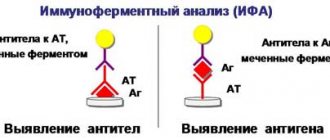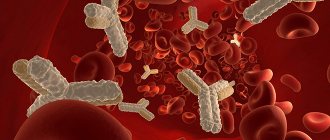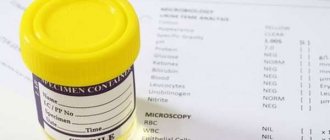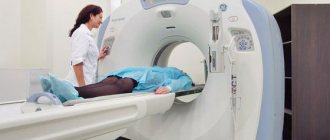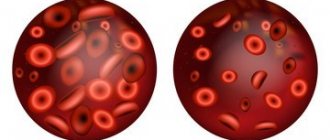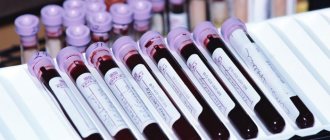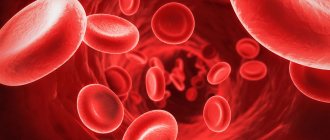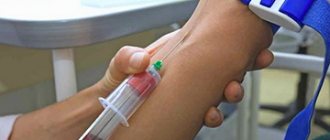0
Author of the article: Marina Dmitrievna
2017.08.03
90
Blood analysis
There are many methods for studying blood to determine various diseases; the biomaterial is taken from a finger or from a vein. Such studies are carried out without any problems, and the reagents are affordable, which is why any medical institution performs tests for free. However, the RW blood test alone does not provide enough information to the doctor.
This study is being conducted to determine the presence of markers of syphilis in adults. The disease refers to sexually transmitted diseases of an infectious nature. Accordingly, specific antibodies are produced in the blood to combat developing pathology. Their presence is detected during an analysis called the “Wassermann reaction” or RW analysis.
Indications for testing
Indications for the study are as follows:
- During a routine medical examination.
- When registering during pregnancy.
- If in doubt, check for the absence of sexually transmitted diseases, HIV.
- After sexual contact with an unverified partner.
- Before donating blood.
- Upon admission to inpatient therapy.
- In correctional colonies.
- In the treatment of syphilis to determine its effectiveness.
- Before surgery.
The following risk groups of the population have been identified for mandatory research:
- Medical workers.
- Drug addicts and people in contact with them.
- Workers of industrial enterprises.
Analysis is recommended if the following symptoms occur:
- constantly elevated temperature;
- bone pain;
- ulcerative formations, violation of the integrity of the skin in the genital area;
- abnormal vaginal discharge in women;
- the appearance of a rash on the skin;
- enlarged lymph nodes;
- dull, aching pain in the heart area.
RW blood test - what is it, features of the technique and where is it used?
This type of study is carried out in a laboratory and is mandatory in several standard situations. Referral for inpatient treatment, before surgery, obtaining a certificate of general health, when prescribing treatment in a sanatorium or resort - all these moments require a mandatory blood test using this method. Many healthy people are interested in how necessary an RW blood test is, what is it and what is its essence?
General provisions
A blood test for RW is the main indicator of the presence and destructive activity in the human body of Treponema pallidum - the cause of the disease such as syphilis. The main feature of this infection is a long latent period during which the main processes that destroy the body occur. At the same time, the person does not show any signs of pathology, continuing his normal life, he actively spreads the infectious agent among his environment.
The serum of patients is a carrier of paired complexes that attract syphilis pathogens. In this case, hemolysis processes are prevented and blocked, red blood cells are not physiologically destroyed. The analysis is simple in technology and allows you to obtain reliable data.
Based on the study of ten milliliters of venous contents, a blood test - the Wasserman reaction - allows you to determine the level of hemolytic processes. The condition is conditionally assessed from one plus to four pluses. The accuracy of determining the presence of infection in the body is high.
Interesting Facts
A fairly well-known blood test for RV has been used for more than a century, and not all people know the numerous facts regarding the discovery of this method. At the turn of the nineteenth and twentieth centuries, the so-called sexual revolution, freedom of morals, and a passion for drugs led to a significant increase in sexually transmitted infections. The treatment methods of that period did not bring the desired effect; there was no full opportunity to conduct the necessary examination to identify the pathogen.
Back in 1906, an immunologist from Germany, Wasserman, proposed a special test to diagnose syphilis. It was easy to use and quickly became a standard examination in many countries, including domestic practice since 1928. The world medical community immediately recognized the significance of the discovery, and a few years later the modest scientist became a baron with all the titles due.
When diagnosing various diseases, various blood tests are prescribed. One of them is general. Read about its decoding here. Find out what a biochemical blood test will show in this article.
Demand for analysis
Despite the simplicity and elementary nature of the technique, many people do not see its usefulness and ask rv blood test what is it? It is unique in that it provides a huge range of possibilities:
- Making a final diagnosis in the early stages of syphilis.
- Determining the timing of probable infection is from 50 to 90% accurate.
- Confirmation of the diagnosis in the latent phase, neurosyphilis and visceral form.
- Monitoring the effectiveness of therapy and during deregistration.
The decoding of rw blood tests and other types of tests is a good opportunity to identify contact persons, carry out prevention, and obtain data for a forensic examination for a complete picture of a criminal violation.
There are certain parameters for assessing these results. The presence of so-called pluses is not a guarantee of infection with syphilis.
Positive reaction results are given by tuberculosis, pneumonia, various stages of rheumatism, post-vaccination conditions.
Diagnosed drug addiction, alcoholism, diabetes mellitus, addiction to fatty foods, pregnancy can significantly spoil the clinical picture of the results.
Who should be diagnosed with RW?
The most important result of a blood test using the method of August von Wasserman is an accurate result in determining the circle of carriers of the infectious agent and preventing further spread of the infection among healthy people.
Instructive documents legally indicate mandatory examination of certain groups of people and professional areas.
The main ones are:
- catering establishments, food factories, retail outlets;
- full staff of medical institutions;
- a group of drug addicts and dependent people;
- regular and spontaneous donors who donate blood, sperm, tissue;
- contingent of contacts with the identified patient;
- people who initially sought medical help;
- patients requiring surgery or hospital treatment.
It is mandatory to take an RW blood test for people who have been complaining of fever for a month or more with other symptoms.
The population that should undergo this analysis are pregnant women when registering at the consultation (along with other women's studies), patients with complaints of causeless pain in the joints and bones. It is especially important to undergo this test after casual sexual intercourse and when diagnosing clinical symptoms of syphilis - such as the appearance of ulcers on the genitals, heavy discharge, skin rash, and significant enlargement of lymph nodes.
Typically, the main conclusions that can be drawn with a positive result are the presence of any form of syphilis, a recurrent reaction, the need for differential diagnosis of all conditions and diseases that can cause similar reactions.
The discovery of a talented German immunologist led to further improvements in tests, which allowed it to become a screening study. This makes it possible to quickly study multiple patients simultaneously.
labmed24.ru
Conducting research
Before donating blood for an RW test, you don’t need to prepare much, but you shouldn’t forget about the following rules:
- Only take a blood test on an empty stomach.
- Do not drink any drinks other than water 12 hours before the test.
- Do not take medications in the morning.
- Quit smoking for at least 12 hours.
If after the study shows a negative value, this does not mean that the person does not have syphilis, since in the primary and tertiary stages of the disease the result is negative. The same reaction is observed against the background of destruction of red blood cells. A positive test is determined based on the stage of the disease (1, 2 or 3 with a + sign).
Study of biomaterial for the Wasserman reaction
Important! The primary stage is also not always detected by a blood test for RW. During the first 2.5 weeks after infection, the answer is always negative.
Many patients wonder what the Wasserman reaction is, what it shows, and how many days the blood test takes. It is worth remembering that this analysis directly determines the presence of antibodies. They are any proteins that appear during infectious and allergic reactions, and in large quantities.
This suggests that a test with a positive result does not mean syphilis; another pathology may masquerade as this disease. In this case, the result is called a false positive. In such situations, the patient undergoes a more thorough examination.
If blood is taken from a finger, then with a sluggish course of syphilis in the initial stage, when the amount of antibodies is small, the answer is negative, although the disease is present. This result is considered a false negative.
Attention! The importance of a blood test for the Wasserman finger test is not so high in modern medicine, so it is not always advisable to carry it out. The most accurate results are obtained after a blood test, which is taken from a vein. Unlike capillary blood, it is possible to separate plasma from venous blood, where the bulk of antibodies are concentrated. This allows us to achieve the most reliable results.
Blood test rw: indications, essence of the study and interpretation of results
The rw blood test is one of the methods for diagnosing syphilis; this method refers to screening (indicative) tests used in mass examinations. A positive or negative test result does not guarantee the presence or absence of a pathogen in the body. To make an accurate diagnosis, treponemal methods are used, which make it possible to identify the disease in the early stages and recognize a false-positive result.
Persons for whom analysis is mandatory
There are a number of citizens for whom taking a (sometimes periodic) blood test for syphilis is mandatory. These include:
— patients who first sought help at the clinic; - patients before admission to the hospital for treatment; — people with drug addiction; — donors who donate sperm, blood, tissue or other body secretions; — healthcare workers, catering workers and food retail outlets; - people who had contact with patients infected with syphilis;
- patients with fever that does not go away for more than a month and other suspicious symptoms (enlarged local lymph nodes, etc.).
The need for a blood test in such a wide range of people is explained by the insidiousness of syphilis - it can be asymptomatic for a long time. In this case, the patient is unaware of the infection, while leading his usual lifestyle, thereby exposing others to danger. Therefore, the main task of the rw analysis is to detect syphilis as early as possible.
Blood test for syphilis: Wasserman reaction
The Wasserman reaction is another name for a blood test for rw; this method was the very first way to determine syphilis. Its main advantage is the ease of performing the reaction, which allows it to be used as a method of primary diagnosis in large groups of people. For analysis, 10 ml of venous blood is taken (it is collected in the morning on an empty stomach).
The essence of the study is to detect paired complexes in the patient’s blood serum. Such complexes adsorb pathogen substances that have entered the patient’s body. There are no such complexes in the blood of a healthy person. In the blood of a healthy person, red blood cells are destroyed, called hemolysis. The presence of such a phenomenon is considered a negative reaction to the disease. In the absence of hemolysis, specialists evaluate the degree of reaction, depending on the stage of the disease (indicated by several “+” signs, from 1 to 4). Primary syphilis is divided into two stages:
- seronegative. In this case, a negative Wasserman reaction is not a reliable sign of the absence or presence of syphilis; more accurate diagnostic methods must be used to make a diagnosis; - seropositive. Such a reaction, as mentioned above, has varying degrees of severity: - results 1+ and 2+ are considered weakly positive; — 3+ is positive;
- 4+ is called sharply positive.
In general, the Wasserman reaction can produce a positive result only after 6 or 7 weeks. In this regard, the following pattern is observed:
— during the first 17 days, patients’ reaction to the test may be negative; - in the 5th week, the test is positive in only a quarter of the sick;
- from the 7th week in most patients the test becomes positive.
Indications for use
In addition to groups of people who must be examined, an rw blood test is prescribed in the following cases:
when planning pregnancy; - the appearance of pain in the bones; - during casual sexual contact; - with heavy discharge from the genital tract and the appearance of ulcers on the genitals; - when rashes appear on the mucous membranes and skin, enlarged lymph nodes;
— during preventive examination and preoperative preparation.
Rw blood test: interpretation
The results of the Wasserman reaction are evaluated as follows:
Positive result:
- possible in the first year after treatment of syphilis;
- seropositive syphilis (any form, from primary to tertiary).
Negative result:
- absence of disease;
— it is possible to have early primary or late stage tertiary syphilis.
In addition, the possibility of a false positive result cannot be excluded, which may be due to the following conditions:
- pneumonia; - tuberculosis; — condition after vaccination; — oncological diseases; - pregnancy; — drug addiction and alcoholism; - diabetes mellitus;
- viral hepatitis.
In our medical center you can perform a high-quality blood test for syphilis; for this, the clinic has everything you need: qualified personnel, excellent diagnostic equipment and the best laboratory materials. Accurate and timely diagnosis is especially important in the case of syphilis, because the main thing is to determine the initial stage of the disease, this will simplify the course of treatment as much as possible and shorten its duration.
diagnostic-md.ru
How long does the analysis take?
The length of time you wait for research results directly depends on the workload of the laboratory in which the research is carried out. Most often, the answer is received within two days after taking the biomaterial.
However, special cases are always taken into account, for example, a patient enters the hospital with dangerous injuries, severe pain, open bleeding, and requires urgent surgery. In such situations, the analysis is performed urgently, and the result is ready within a few hours.
Patients should know how long the analysis of the biomaterial used is valid: it is valid only for three months after it is carried out, then, if necessary, it is repeated.
Analysis result
Iron – why does the body need it?
Iron (abbr. Fe) is a substance necessary to support life. Thanks to it, the body forms normal red blood cells, since this element is the main part of hemoglobin, which is part of these blood cells. It binds and attaches oxygen molecules to itself in the lungs and gives them to other parts of the body, taking waste gas - carbon dioxide - from the tissues, bringing it out.
To provide body cells with iron, the liver produces the protein transferrin from amino acids, which transports Fe throughout the body. When Fe stores in the body are low, transferrin levels increase.
Conversely, as iron stores increase, the production of this protein decreases. In healthy people, one third of the total amount of transferrin is used to transport iron.
Fe residues that are not used for cell construction are stored in tissues in the form of two substances, ferritin and hemosiderin. This reserve is used to produce other types of proteins, such as myoglobin and some enzymes.
Decoding
The interpretation of a blood test for RW may be as follows:
RW negative
What does the absence of antibodies to the causative agents of sexually transmitted diseases mean, that is, a person does not have syphilis.
RW positive
There are four degrees of reactions, which are indicated with a “plus (+)” sign, and it must be remembered that the greater the number of reactions indicated in the study results, the higher the likelihood of the presence of the disease. If such results occur, a mandatory re-examination is prescribed.
Attention! Patients who have had syphilis after treatment may remain positive for the rest of their lives with four advantages.
Carrying out analysis in the laboratory
RW false positive
May occur in the following situations:
- Progressive inflammatory response in the lungs, including tuberculosis.
- Pathologies affecting connective tissue.
- Arthritis of various etiologies.
- The body's reaction after the administration of vaccines.
- Condition after suffering infections of various origins.
- Pregnancy period.
- Oncological neoplasms.
- Diabetes.
This also includes hepatitis and HIV.
If doubts arise after a blood test for the Wasserman reaction, then additional diagnostic methods are prescribed at a more modern level. For example, in adults, blood is taken from a vein for RIF and ELISA - they give the most reliable results.
If the response to the test is negative, the presence of sexually transmitted pathology cannot be completely ruled out, since antibodies can only be detected after a certain period of time.
Types of tests for syphilis
There are two types of tests: non-treponemal and treponemal. The first option involves the use of artificial analogues of Treponema pallidum; in the second case, real treponemes are used.
Non-treponemal methods
Such techniques are widespread and are most often used in routine medical examinations.
The advantage is low cost, quick results, and the ability to conduct research using standard laboratory equipment.
Analysis on RW
To carry it out, blood is taken from the patient, and less often, cerebrospinal fluid. Blood can be taken from a finger or a vein. The error in conducting such a study can be up to 7%.
Precipitation microreaction (MR or RMP)
May include two types of syphilis tests RPR and VDRL. As a result of cell breakdown under the influence of treponema, antilipid antibodies are formed.
Lipids can be destroyed under the influence of other disorders, so the degree of error when performing VDRL and RPR is 1-3%.
Treponemal tests
Such studies are not carried out in all clinics and require expensive equipment.
Therefore, they are used when the presence of the disease is suspected based on the results of non-treponemal tests. The error of such studies is less than 1%.
REEF
Allows you to determine antigens and antibodies. To determine the result, the patient donates blood from a finger or vein. As a result, testing also helps determine the stage of the disease.
RPGA
The RPHA syphilis test allows you to determine the percentage of red blood cell adhesion. The exact result of the passive hemagglutination reaction can be obtained on the 28th day after infection.
ELISA
Enzyme immunoassay determines the presence and stage of the disease based on the level of immunoglobulins of various types.
A positive syphilis ELISA allows you to determine the types of immunoglobulins that are formed after infection for 14 days, 14-28 days, more than 28 days.
PCR
The most accurate test to detect pathogenic DNA. It is used in rare cases, as it requires complex reagents.
The probability of error of the RIF, RPGA, ELISA tests is less than 1%. With PCR, the error can be 0-1%.
Assessment of ferrokinetic parameters. Stages of development of iron deficiency in the body
V. ASSESSMENT OF FERROKINETIC PARAMETERS.
According to modern concepts, ferrokinetic parameters can be assessed based on measurements of the following parameters: 1) Hb concentration. 2) Serum Ferritin (SF) is an iron protein that characterizes deposited iron in the body. 1 µg/l SF corresponds to 8 mg of reserve iron. 3) Serum Iron (SI) is iron bound to the transferrin protein. Therefore, another name for serum iron is bound serum transferrin. 4) Free Transferrin (TF) is transferrin not bound to iron. 5) Total Iron Binding Capacity of Serum (TIBC) - characterizes the capacity of transferrin circulating in the plasma. It is a combination of free and bound serum transferrin. 6) Transferrin Iron Saturation Coefficient (CST). CST is the ratio of serum iron concentration to serum transferrin concentration, expressed as a percentage.
7) Percentage of hypochromic erythrocytes in peripheral blood. The percentage of hypochromic erythrocytes is defined as the % of cells with a reduced Hb concentration in an individual cell. Normally it should be less than 2.5%. The content of hypochromic erythrocytes over 10% indicates functional iron deficiency in the body. Concentration of protoporphyrins in erythrocytes. When iron metabolism is impaired, due to depletion of its reserves in the body, the concentration of free protoporphyrins in erythrocytes exceeds the upper limit of normal. 9) Examination of bone marrow punctate with staining for iron. With a decrease in the reserve iron fund, the number of sideroblasts (erythrokaryocytes containing iron granules) is reduced. The method is invasive. Not used in pregnant women. 10) Measurement of the concentration of soluble transferrin receptors (TF-R). Most cells contain receptors for TF on the membrane, which are necessary for the entry of iron into the cell. Transferrin receptor is a transmembrane glycoprotein. The more iron there is inside the cell, the more actively ferritin is formed and the less pronounced the expression of TF receptors on the membrane. With depletion of iron reserves and the development of IDA, there is an increase in the synthesis and expression of membrane transferrin receptors and their concentration in the serum increases.
The percentage of hypochromic erythrocytes is defined as the % of cells with a reduced Hb concentration in an individual cell. Normally it should be less than 2.5%. The content of hypochromic erythrocytes over 10% indicates functional iron deficiency in the body. Concentration of protoporphyrins in erythrocytes. When iron metabolism is impaired, due to depletion of its reserves in the body, the concentration of free protoporphyrins in erythrocytes exceeds the upper limit of normal. 9) Examination of bone marrow punctate with staining for iron. With a decrease in the reserve iron fund, the number of sideroblasts (erythrokaryocytes containing iron granules) is reduced. The method is invasive. Not used in pregnant women. 10) Measurement of the concentration of soluble transferrin receptors (TF-R). Most cells contain receptors for TF on the membrane, which are necessary for the entry of iron into the cell. Transferrin receptor is a transmembrane glycoprotein. The more iron there is inside the cell, the more actively ferritin is formed and the less pronounced the expression of TF receptors on the membrane. With depletion of iron reserves and the development of IDA, there is an increase in the synthesis and expression of membrane transferrin receptors and their concentration in the serum increases.
The most accessible and common parameters characterizing iron metabolism are the first 6 indicators listed above, which represent the main tool in diagnosing the stages of ID in the body of pregnant women.
VI.STAGES OF DEVELOPMENT OF IRON DEFICIENCY IN THE BODY.
There are three forms of iron deficiency anemia: iron deficiency without anemia (prelatent and latent) and iron deficiency anemia. The first two are characterized by a decrease in stored and transported iron with a preserved erythrocyte iron pool, the second - by a decrease in the level of all metabolic iron pools.
Prelatent iron deficiency is a condition that precedes iron deficiency and is accompanied by increased absorption of iron in the gastrointestinal tract. There are no clinical symptoms. Laboratory parameters (peripheral blood picture, serum iron, transferrin, ferritin) usually remain within normal limits. The only test that can actually determine the depletion of stored iron is the 59 Fe 3+ absorption test. In approximately 60% of cases, an increase in absorption of more than 50% is detected when the norm is 10-15%.
Latent iron deficiency is accompanied by so-called sideropenic symptoms caused by iron deficiency in tissues.
Laboratory indicators of iron metabolism are characterized by a decrease in the concentration of ferritin (5-15 μg/l), serum iron in plasma, and an increase in transferrin. When iron stores are depleted, a deficiency of transport iron develops, although the synthesis of Hb at this stage is not impaired and, therefore, red blood indicators: Hb, hematocrit Ht, red blood cells (RBC), mean erythrocyte volume (MCV); average Hb content in the erythrocyte (MCH); the average concentration of Hb in the erythrocyte (MCHC) remains within normal limits. However, with additional stress or iron loss, latent iron deficiency can develop into IDA.
The final stage of VDS is iron deficiency anemia , which occurs when the hemoglobin pool of iron decreases and is manifested by symptoms of anemia and hyposiderosis.


